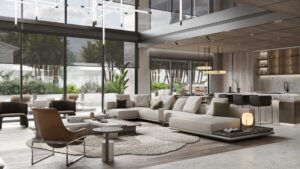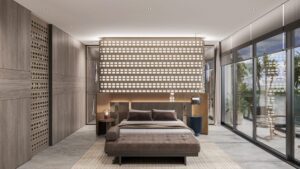TEAM Project » Blog » Modern Interior Design: A Guide to Style and Theory

Modern Interior Design: A Guide to Style and Theory
Modern interior design has become a defining style in today’s homes, reflecting simplicity, clean lines, and functional spaces. With its focus on minimalism and an emphasis on materials, the style continues to evolve while remaining rooted in its mid-century origins. Whether you're redesigning a room or an entire house, understanding the theory behind modern design is key to creating a space that feels fresh, open, and timeless.
What is Modern Interior Design Style?
Modern interior design is a style that emerged in the early to mid-20th century, driven by the modernist movement in art and architecture. It prioritizes clean lines, a neutral color palette, and minimal decoration. At its core, modern design embraces simplicity and functionality over excessive ornamentation. The design focuses on highlighting structural elements like glass, steel, and concrete, making the architecture of the space itself a central element.
Some defining characteristics of modern interior design include:
- Minimalist Aesthetics: Clutter-free spaces with fewer pieces of furniture, often focusing on functionality.
- Natural Light: Emphasis on open spaces and large windows to bring in natural light.
- Neutral Colors: Use of white, black, grays, and beiges, often contrasted with bold accents.
- Natural Materials: The use of wood, leather, and stone, often left in their raw form.
What is the Modern Theory of Interior Design?
The modern theory of interior design revolves around the concept of "form follows function." This principle, rooted in modernist architecture, emphasizes that the design of a space should first and foremost serve its intended purpose. Modern design encourages the use of open floor plans, practical furniture, and a deliberate lack of unnecessary ornamentation.
Key aspects of the modern design theory include:
- Functional Layouts: Rooms are designed to optimize space and flow. There’s an emphasis on open floor plans and multi-functional furniture.
- Geometric Forms: Lines and shapes play a crucial role in modern design, with an emphasis on linear and angular elements.
- Emphasis on Technology: Modern design often integrates the latest in home technology, seamlessly incorporating smart home devices and advanced lighting solutions into the aesthetic.
What is the Difference Between Modern and Contemporary Interior Design?
While modern and contemporary interior design are often used interchangeably, they are distinct styles. Modern design refers to a specific time period, typically from the early to mid-20th century. It is grounded in a set of specific principles focused on simplicity, minimalism, and functionalism.
On the other hand, contemporary design is more fluid and constantly evolving. It borrows elements from various styles and incorporates the latest trends. While modern design tends to have a fixed aesthetic, contemporary design adapts to current tastes, often blending minimalism with elements from other styles like industrial or Scandinavian.
Key Differences:
- Modern Design: Focuses on clean lines, neutral colors, and a specific historical era (mid-century).
- Contemporary Design: Evolves with time and trends, allowing for more flexibility in color, textures, and shapes.
What is Modern Chic Interior Design?
Modern chic interior design takes the foundations of modern design and adds a layer of elegance and sophistication. It blends minimalist principles with luxurious touches to create a space that is both functional and stylish. The chic element comes from the use of high-end materials, metallic finishes, and plush textures, which soften the clean lines and stark geometry of modern design.
Characteristics of modern chic design include:
- Neutral Base with Pops of Color: Like modern design, modern chic uses a neutral palette but introduces bold colors or patterns in accents such as cushions, artwork, or rugs.
- Elegant Materials: Incorporation of high-end materials such as marble, velvet, and brass to add a touch of luxury.
- Statement Pieces: A focus on one or two bold, standout furniture pieces, such as a statement sofa or lighting fixture, that serve as the focal point of the room.
Bringing Modern Interior Design into Your Space
If you're looking to integrate modern design into your home, consider focusing on the essentials: clean lines, functional layouts, and the use of quality materials. Begin by decluttering your space, choosing neutral colors for walls and floors, and selecting furniture that serves a purpose without overwhelming the room. Integrating natural light and maintaining open spaces are also crucial elements of modern design.
Whether you're going for a classic modern look or a modern chic twist, this style offers a fresh and timeless approach that adapts to your needs while maintaining aesthetic simplicity.





